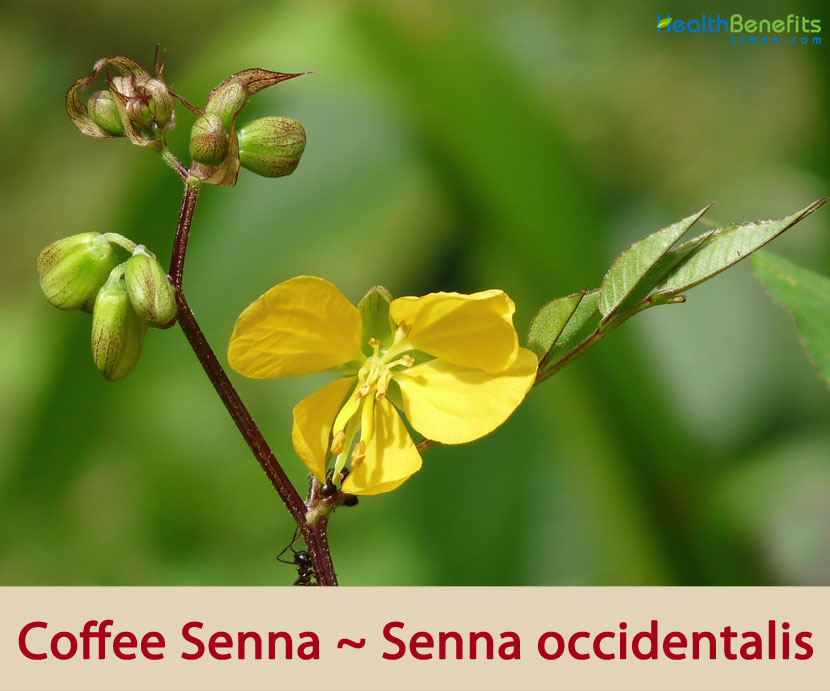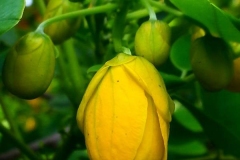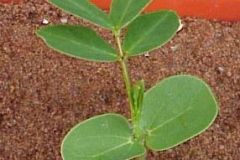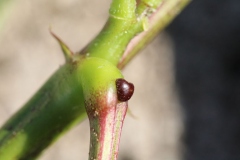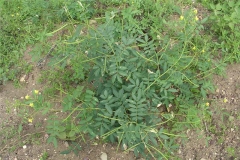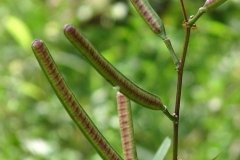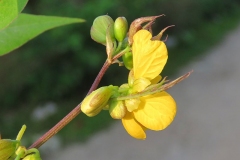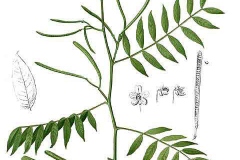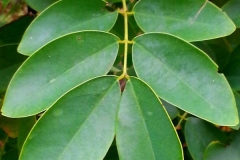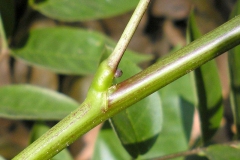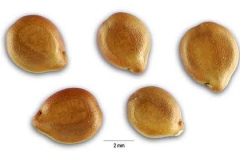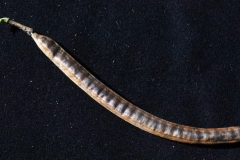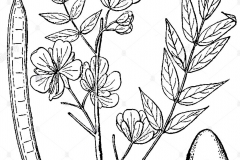Coffee senna got its name from the fact that the seeds it bears can be roasted and used as substitute for coffee. It doesn’t have caffeine so it’s perfect for those who tend to experience palpitations, lightheadedness and other unfavorable symptoms upon ingesting the said substance. The scientific name Senna occidentalis comes from Arabic and Latin roots, with Senna meaning “these plants” and occidentalis meaning “western,” in reference to its origin. While closely related to Sicklepod, Coffee Senna does not respond the same to many of the herbicides used for Sicklepod control in row crop production, making it challenging to control.
Coffee Senna Facts
| Coffee Senna Quick Facts | |
|---|---|
| Name: | Coffee Senna |
| Scientific Name: | Senna occidentalis |
| Origin | Bahamas, Barbados, Belize, Cayman Islands, Mexico and other regions of North American continent |
| Colors | Dark brown |
| Shapes | Flattened, sickle-shaped pod with paler stripes along the edges when mature. Pods are 75-130 mm long, 8-10 mm wide, containing a single row of 25-35 seeds |
| Taste | Bitter, sweet |
| Health benefits | Beneficial for typhoid, malaria, liver complaints, snake bites, diabetes, rheumatism, venereal diseases, fevers, hematuria and convulsion |
| Name | Coffee Senna |
|---|---|
| Scientific Name | Senna occidentalis |
| Native | Bahamas, Barbados, Belize, Cayman Islands, Mexico and other regions of North American continent. Also in the South American subcontinent, it is indigenous to Argentina, Brazil, Ecuador, Colombia, Paraguay, Peru and other regions. It is invasive in parts of Kenya, Uganda and Tanzania |
| Common Names | Septicweed, coffee senna, coffeeweed, Mogdad coffee, negro-coffee, senna coffee, Stephanie coffee, styptic weed, ant bush, arsenic bush, Nigerian senna, sickle pod, stinking pea, stinking weed, stinkweed, Bana chakunda, Fedegoso, Rubbish cassia, Senna coffee, Styptic weed, Foetid cassia, Kasunda, Bari kasondi, Ran-takda, Kasivda, Kasoda, Rankasvinda, Nattam takarai, Nattam takarai, Payaverai, Mattantakara, Thangedu, Kolthogache, Kalkashunda, Kasundri, Kasonji, Hant-thenga, Kasundri, Reng-an, Kasondi |
| Name in Other Languages | Angola: Munhanoka, Diai Arabic: Kasia gharbia (كاسيا غربية) Argentina: Cafeíllo, cafetón Assamese: Jonjoni-goch, Kusum,Hat-thenga Australia: Ant bush, arsenic bean Bengali: Kalkashunda (কলকাসুন্দা) Benin: Husikonu Burmese: Ka.sau.poap, Sham:ka.sau., Sham:ka.zau, Tan.kywè:kri, k hcot pote (ကစော့ပုပ်) Bolivia: Mamuri Brazil: Fedegosa, fedegoso, mata pasta, mata patinho, paramarioba Burkina Faso: Binane, Daon, Berle, Faux kinkeliba Burundi: Umuyokayoka Cambodia: Phak ngot, sânndaèk khmaôch Cameroon: Gin-i-nel Chamorro: Amot tumagá, amot-tumaga, amot-tumaga karabao, karabao, mumutong sapble, mumutun-sable Chinese: Wang jiang nan (望江南 ), Wang jiang nan jue ming (望江南決明), Li cha, Ye bian dou, Gou shi dou, Yang jiao dou, Jiang mang jue ming Chuukese: Afanafan Colombia: Aya-poroto, café de bonpland, hedionda, chilinchile Congo: Sang, Kenkelibo, Ntsumu, Nkia, Ntsuri ntsuri, Munkasa ntari, Onwara tshulu, Bufili buesi, Nkese ntari, Poso jandzo, Leposo jandzo, Elumbatsolo, Buluwatali, Niasi Cuba: Sen, yerba hedionda, Martinica Czech: Kasie západní Danish: Negerkaffe, Neger-kaffe, Kaffe-sennes East Africa: Mnuka uvundo, mwingajini Ethiopia: Assenmeka, hawacho, karrarate English: Antbush, Coffee senna, Mogdad coffee, Negro-coffee, Stinkingweed, arsenic bean, coffee weed, septic weed, Foetid Cassia, Rubbish Cassia, Styptic Weed, Bitterroot, wild coffee, wild French guava Estonian: Läänekassia Fijian: Kau mothe, kavmoce, pini Finnish: Kahvisenna French: Bentamaré, Bonne casse, Pois-puant, Café bâtard, Casse-café, Casse puante, Herbe puante, Séné d’occident, café nege, dartrier, gros indigo sauvage, quinquiliba, souveraine, Gros Indigo a Fleurs Jaunes, Pois Piante, Pois Piante Noir, Pois Puant Noir, cassie puante, herbe puante, café bâtard Gabon: Nyale-kaba, Ebesi, Ngombi-a-nyovi, Bangore, Anumba-numba, Mukemu-mfumbi, Muwiwisi, Igondjo-nyi-nicheri, Nyoka-nyoka Gambia: Kassala, Bantamare, Lubalub, Tiga sowru, Kafura bunang bang German: Kaffeekassie, stink kassie Ghana: Kedeberuba, Mofra Borode, Anase Borode, Denkyenwe, Anansedua, Wame, Akyendaluwa, Kenda Aluwaa, Gbekebii Angmadaabainsa, Bayisa, Dzongbale, Dzovi, Devidevi ipeli-mumu, Agabladzo Guam: Amot-tumaga Gujarati: Kasundri Haitian: Pwapyant Hausa: Raiídor Hawaiian: Au‘auko‘i, ‘auko‘i, mikipalaoa, pī hohono Hindi: Arimarda, bari kasondi, gajarság, hant-thenga, kasamarda, kasivda, kasondi, mattantakara, nattam takarai, payaverai, rankasvinda, ran-takda, vimarda, kasundi, kasonda I-Kiribati: Te katia Indonesia: Kasingsat, kopi andelan, menting Irula: Thagarai Ivory Coast: Adamaduba, Kandabalomba, Matamakankanmanda, Batrankam Banda, Bagale, Zimele Dindin, Ziribidindin Jamaica: Piss-a-bed, stinking weed, wild coffee, dandelion Japanese: Ha busou (ハ ブソウ) , Wa busou (はぶそう) , Bōbù cǎo(波布草), habuso, Kusasen’na (クサセンナ) Kannada: Kolthogache (ಕೋಲ್ತೊಗಚೆ), Aane chogate (ಆನೆ ಚೊಗಟೆ) Kenya: Inglatiang, Msalafu, Mnubobundo, Mnika Uvunda, Mrambazi, Mwingajini, Mrumbuzi, Mbukomavi Kinyarwanda: Umuyoka Korean: Gang nam cha (강 남차), Seok gyeol myeong (석결명), Seok gyeol myeong pul (석결명풀), soggjolmjong Laos: Kh’ét, lang kh’ét, phet Liberia: Bala bleh Malawi: Mjoka Malayalam: Ponnariveeram, Ponnari, Ponnionthakara, Peyaviram, Karinthakara, Mattanthakara, Nathramthakara, ūḷan takara (ഊളൻ തകര) Malaysia: Kachang kota, ketepeng hutan Maldives: Dhigu thiyara Mali: Dine Monu, Turi Ferre, Alia nao Balambala Maori (Cook Islands): Parenga Marathi: Ran-takda, kasivda, kasoda, rankasvinda Mauritius: Casse puante Mexico: Bataban, candelilla chica, cornezuelo, frijol cimarrón, frijol del monte, frijolillo, habilla bicho, vainillo Mizo: Reng-an Mokilese: Apschoh Nahuatl: Ehcapahtli Nauruan: Tan braua Nepali: Kasaudi, Panvar, Tulo tapre (ठूलो ताप्रे), Barkichakor, Chilmile, Gahat, Kwnar, Tapre, Chhinchhin, Kodari phul, Panwar, Sani, Syang Syange Nigeria: Kire, Rere, Rai’ dore Oriya: Kasundri Palauan: Kerieu, korriu, kurriu Peru: Achuporoto, retamilla Philippines: Andadasi, balatong aso, duda, kabal-kabalan, katangan-aso, tambalisa Portuguese: Balambala, Café-negro, Folha-do-pajé, Fedegoso-verdadeiro, Ibixuma, Lava-prato, Mangerioba, Mamangá, Mata-pasto, Maioba, Pajamarioba, Pereriaba, Taracurú, Mangirioba, Manjirioba, cana fista, cana fistula, folha-de-page Puerto Rico: Casia, casia glauca, hedionda, Cana fista, Vainillo, Pigue pajaro, Fedegoso, Pajamarioba, Magerioba, Achuporoto Russian: Kassiya otsidentalis (Кассия оциденталис), Kassiya zapadnaya (Кассия западная), Senna zapadnaya (Сенна западная), kofeynaya senn (кофейная сенн) Rwanda: Umuyoka, Umwikanzoka, Kisogera Somalia: Fihaari, Dirjinni Samoan: Lau matui Sanskrit: Arimarda, kasamarda, vimarda, Senegal: Mbetambre, Xob Bu Adana Bate, Bata, Benefine, Betafenee, Nani, Mbala mbala fin, Ala nao, Turifere, Kasalo, Kasala, Tasbati, Schabali, Adana, Aldana, Kaputa bana, Akade eyofum, Dakemal, Kasala, Fedegosa, Makakase, Faux kinkeliba, Herbe paunte Seychelles: Casse puante, stinking weed Sierra Leone: E-bambafoke, Bamba Fokie, Dila-kindo, Sabibosue-le, Stinkin-lif Sinhalese: Pani thora, Peni-tora South Africa: Ikhoshokhosho, isinyembane, stinking weed, umnwanda-nyoka, wild coffee, Moshabela moha, Tsinyembane Spanish: Bicho, aya-porotillo, aya-poroto, bataban, bricho, brusca, cafe de bonpland, cafecillo, frijolillo, guanina, hedionda, mezquitillo, rematilla; taperiba, achuporoto, caña-fista, hierba hedionda brusca, manjeiroba, pico de pájaro, café cimarrón, frijolillo negro, vainillo, pigue pájaro, brusca chuquichique Swahili: Mwengajini, Mwengia Tamil: Paayavarai, Nattam takarai Tanzania: Komanguku, kundekunde, mwitanzoka, omwetanjoka, segusse, Kunde nyika, Ntamba nzoka, Tamba nzaka, Megeiee, Sugusse, Linsegiri, Manzegenzge, Mwanhajini, Zamnala, Simbe, Kundekunde, Mlingajini, Komanguku, Muinu, Mkutu, Mwilanziba Telugu: Thangedu, Kasinda (కసింద) Thai: Chumhet lek (ชุมเห็ดเล็ก), Lang khet, Khet Togo: Awakofin, Awakolif, Adakayi, Awakognifan, Awakofe Trinidad and Tobago: Negro coffee, wild coffee Tongan:Pi, te‘epulu, tengafefeka Urdu: Kasonji Uganda: Etiatia, kasagaly ansasi, kwiniini omuganda, mutanjoka, mwitanzoka, namaseze, omuhanga, Omwita-njoka, Ekayeriyer, Umuthanjoka Vietnamese: Cây muồng hòe, Muồng hòe, Muồng tây West Indies: Pois Puat Zambia: Loeni, Cynialala, Mucerere Ziare: Tchungu-tchungu, Abokotul, Obokotul, Bao, Bomingolanta, Logondjolo, Etukuluku, Inaola a diliki, Lituku, Ileleko, Kinkiliba, Kinkiloba, Kivantala, Kankundagunda, Konde, Lembe, Okasam mangue, Mobengo-lataba, Lulanga-budjibudji, Tchimbele bele, Mujoka, Mutsutshungu, Mushemanjoka, Munzangi nzango, Nioka nioka, N’tande, N’zanga, N’zungu, N’tu, Zakeke, Tete buangila |
| Plant Growth Habit | Low growing, sparsely branching annual or short-lived perennial herb to small shrub |
| Growing Climates | Roadsides, in cane fields, coconut plantations, degraded pastures, grasslands, open fields, river banks or sand dunes, wilderness tracts, arable lands, waste places, lakeshores, coastal sand flats. It is also found around urban areas, open fields, plantations, sand dunes, ditches and seasonally wet depressions |
| Plant Size | 0.8-1.5 m tall |
| Root | Robust primary root with several laterals |
| Stem | Reddish purple, erect, 4-angled when young, becoming rounded with age |
| Leaf | Lanceolate or ovate-lanceolate, bipinnately compound, and about 20 to 25 cm in length. Each pinna has four to seven pairs of leaflets, which are 3 to 9 cm in length, and 2 to 4 cm in width, and arranged oppositely |
| Flowering season | April-October |
| Flower | Flower grows in the leaf axis. They have green sepals which is 6 to 9 cm long. There are 5 petals; which are yellow in color which have distinct red veins and 1-2 cm long |
| Fruit Shape & Size | Flattened, sickle-shaped pod with paler stripes along the edges when mature. Pods are 75-130 mm long, 8-10 mm wide, containing a single row of 25-35 seeds |
| Fruit Color | Dark brown |
| Seed | Dark brown, flattened, hard, 5 mm long and 3 mm wide |
| Top Products Containing Coffee Senna |
|
| Propagation | By seed |
| Flavor/Aroma | Characteristic fetid odor |
| Taste | Bitter, sweet |
| Plant Parts Used | Whole plant, seeds, leaves, root |
| Season | May-December |
| Health Benefits |
|
| Other Facts |
|
Plant Description
Coffee Senna is a low growing, sparsely branching annual or short-lived perennial herb to small shrub that normally grows about 0.8-1.5 m tall. The plant is found growing in roadsides, in cane fields, coconut plantations, degraded pastures, grasslands, open fields, river banks or sand dunes, wilderness tracts, arable lands, waste places, lakeshores and coastal sand flats. It is also found around urban areas, open fields, plantations, sand dunes, ditches and seasonally wet depressions. The plant has robust primary root with several laterals roots. Stems are reddish purple, erect, 4-angled when young, becoming rounded with age.
Leaves
Leaves are lanceolate or ovate-lanceolate, bipinnately compound, and about 20 to 25 cm in length. Each pinna has four to seven pairs of leaflets, which are 3 to 9 cm in length, and 2 to 4 cm in width, and arranged oppositely. Leaflets are ovate or ovate lanceolate in shape with a long, fine pointed tip and is green in color. The leaflets have an entire leaf margin. The leaf apex is acuminate and has fine hairs on the margins of the leaflets. A conspicuous, dark-colored gland occurs at the base of the petiole (leaf stalk) but not on the stalks of the leaflets. It is located about 0.3 to 0.5 cm from the base of the petiole. On crushing of the leaf, there is a fetid smell which is a characteristic of the herb.
Flower
The flower grows in the leaf axis. They have green sepals which is 6 to 9 cm long. There are 5 petals; which are yellow in color which have distinct red veins and 1-2 cm long. Stamens of the flower are different in length and are 6 to 7 in number. The ovary of the flower is tomentose and is monocarpellary. The plant gives flowers throughout the year.
Fruit
Fertile flowers are followed by dry, dehiscent seed pods, 8 to 12 cm long and 7-10 mm wide. It is laterally compressed and transversely partitioned. Flowers are initially green turning to dark brown as they mature. The seeds are dark brown in color. They are 3.5-4.5 mm wide in size and oval in shape with pointed end. The surface of the seed is smooth and is flat. The seeds can be roasted and made into a coffee-like drink.
History
The plant of coffee senna is native to Bahamas, Barbados, Belize, Cayman Islands, Mexico and other regions of North American continent. Also in the South American subcontinent, it is indigenous to Argentina, Brazil, Ecuador, Colombia, Paraguay, Peru and other regions. It is introduced in various other countries like Egypt, Angola, Madagascar, Mauritis, Mali, Hawaii, Papua New Guinea and various other countries. This plant is spread widely throughout the continent of Asia. It can be found in Bangladesh, Bhutan, China, Brunei, Hong Kong, India, Iran, Iraq, Japan, Nepal, Pakistan and other regions. In the Indian subcontinent Cassia occidentalis grows up to an altitude of 1500 m. It can be found in Andhra Pradesh, Sikkim, Lakshadweep, Andaman and Nicobar Islands and in Gujarat.
Health benefits of Coffee Senna
Listed below are some of the popular health benefits of using Coffee Senna
1. Relieves Acid Reflux
Everyone who suffers from acid reflux knows that a cup of coffee is a no-no because it’s a big trigger. If they already miss drinking coffee, they can always go for coffee senna. They may consume it, too, if they are being pestered by acid reflux because it is actually very good at neutralizing excess stomach acid.
2. Promotes good digestion
Cup of coffee senna may be taken after meals to facilitate proper digestion of food, thus keeping an upset stomach at bay. Consumption of coffee senna is also recommended for people who are prone to constipation.
3. Kills off Parasites
Perks of drinking coffee senna to the digestive system do not begin and end with controlling acid reflux and constipation. Individuals who are believed to have parasitic worms in the intestines can also benefit from the intake of coffee senna. It’s also known to put abdominal cramping and distention under control.
4. Deal With Anemia
Coffee senna supplies the body with iron, a mineral that’s necessitated for the production of red blood cells or RBCs. It’s for this reason why this invasive weed is regarded traditionally as a remedy for iron-deficiency anemia.
5. Controls Inflammation
Traditional healers also used coffee senna for the management of various health issues that are inflammatory in nature. Since it has the ability to control inflammation in the body, it is commonly used for lowering a person’s risk of heart disease and cancer. Coffee senna is also known to be very good against joint pain and swelling.
6. Treats Many Skin Issues
Coffee senna may be turned into poultice, infusion or paste that can be used for dealing with a host of skin problems. Some of them include rash, insect bites, acne, psoriasis and eczema.
Traditional uses and benefits of Coffee Senna
- It is a traditional remedy for ailments such as typhoid, malaria, liver complaints, snake bites and dog bite.
- It is also used to treat diabetes, pains, rheumatism, venereal diseases, fevers, hematuria and convulsion.
- It is used in Ayurvedic traditional medicine in India, being the source of the drug Kasamarda.
- The whole plant is diuretic, febrifuge, stomachic and tonic.
- It is used in the treatment of hypertension, biliousness, ringworm and eczema.
- Plant is boiled and gargled for treating throat troubles.
- Externally, it is pounded and mixed with wood-ash and rubbed on areas of leishmaniasis and eczema.
- The root is cholagogue, emetic and purgative.
- An infusion is used in the treatment of bilious fever, ordinary fever, stomach-ache, and to ease menstruation.
- Tincture of the root is rubbed onto rheumatic areas.
- Tea made from roots and dried flowers is used as a treatment for colds and upset stomach.
- Leaf is used as a remedy for renal calculi.
- Leaves are made into a tea for treating afterbirth problems, fevers, coughs and colds, headaches, hemorrhage and thrush.
- An ointment prepared from the leaves is applied as a remedy for ringworm and other affections of the skin.
- Flowers are used in a preparation to reduce stomach acid in children.
- The seed is febrifuge and sedative.
- An infusion is drunk to calm one’s nerves, and as a treatment for kidney problems, hemorrhage, worms, and cleaning womb and tubes.
- Extracts of the leaf and seed have shown antibiotic activity.
- Seeds are roasted, brewed and served as tea to treat hemorrhoids, gout and diabetes in Jamaica.
- This plant is mainly used for the treatment of bone fractures and bone dislocation as an herbal treatment in India.
- It is used for treatment of whooping cough, convulsions, heart disease, snakebite, asthma, fever, and the flu.
- All plant parts are said to have tonic, diuretic, stomachic and febrifuge properties and are especially used for dropsy, rheumatism, fevers and venereal diseases.
- An ointment prepared is also used to treat all kinds of skin diseases (e.g. ringworm, eczema).
- Roots are especially used as an anthelmintic and against malaria and hematuria.
- An infusion of the bark is applied as a remedy for diabetes.
- The leaves are used as a purgative and antiherpetic, and a poultice is administered against toothache in Indonesia and against headache in Malaysia.
- Seeds are used in the treatment of whooping cough, disease of heart.
- Paste prepared from leaves of the plant is taken in the dose of 1 gm. twice a day to treat colic pain.
- Bark infusion is useful in diabetes.
- Root of the plant is used in intermittent fevers, as a tonic and diuretic.
- The Indians use again the roots and seeds to treat dyspepsia and flatulence.
- Indians also use the leaves and seed to treat hiccough.
- Decoction of the leaves, roots and flowers is useful in relieving flatulence of dyspeptic and nervous women.
- Roots are used to treat and fortify the liver in Peru and Brazil.
- Leaves are used in the treatment of hepatitis in some countries in Africa.
- An aqueous decoction of the leaves or the whole plant is used to treat jaundice and fever in Benin.
- Juice of the roots is anthelmintic and taken 6 teaspoon at bed time and is also given for fever in Nepal.
- Seeds are brewed into a coffee like beverages and given in cases of asthma while the flower infusion is used for bronchitis.
- Coffee senna is used in treatment of sore throat, colds & flu and asthma in Suriname.
- Leaves and seeds are considered expectorant and is used to treat cough, whooping cough and bronchitis.
- African healers prescribe infusion of the leaves or boiled roots to treat their fevers, but the Congo healers warm leaves, macerate them in water and use this to bathe their patients with.
- Malays used a decoction of the roots to treat this condition especially those associated with bleeding.
- Leaves are used to treat gonorrhea and various urinary tract disorders.
- The Brazilians use the roots and the leaves to address menstrual problems.
- Mistiko Indians of Nicaragua uses the decoction of the whole plant to treat uterine pains and dysmenorrhea.
- Decoction of the roots is being used to ease delivery in Congo.
- Creole society used the root decoction and infusion for inflammation of the uterus and to induce abortion.
- Leaves whether fresh or dried has been found to be suitable for use in treatment of skin disorders, fungal and parasitic skin diseases and inflammatory skin conditions.
- Indians use the roots to treat fungal infections of the skin, the leaves to control pruritus, treat wounds and ulcers while the seeds for more sinister skin infections like leprosy and erysipelas.
- The Chinese use it to treat hypertension.
- Pounded fresh material is applied as poultice for snakebites.
- Roots are used for gonorrhea, black-water fever, malaria, and dysentery.
- Decoction of roots used for fevers; seeds brewed for asthma in Peru.
- Poultice of leaves are used for skin irritation and eczema.
- Leaf infusion used as specific for black-water fever in Lagos.
- Poultice of leaves used for toothache in Dutch Indies.
- Infusion of leaves is used for yellow fever in French colonies of western Africa.
- Poultice of leaves used for headache in Malaya.
- Fresh leaves used for constipation and malaria; also use as enema for its abortive properties in African pharmacopoeia
- In Nigeria, leaves are used for the treatment of measles: Dried root and leaves are milled and mixed with black soap and used to bathe twice daily.
- In Zambia, traditional healers used the roots for treatment of gonorrhea.
- In African traditional medicine, it is used for treatment of hypertension and associated cardiovascular diseases.
- In Andhra Pradesh, India, the leaf and stem is used for treating fractures and bone diseases.
Home Remedies using Coffee Senna
- Eczema and psoriatic patches: The seeds or leaves of coffee senna are crushed to make a paste and this paste is applied on affected area of the skin. Regular application can result in relief from eczema and psoriatic patches.
- Allergic dermatitis patches: When the mixture of the root and seed of Coffee senna is mixed with gandhapashana and applied topically on the affected area there is a significant reduction and cure of allergic dermatitis patches.
- Ring worm and tinea infections: The seeds or leaves of coffee senna are crushed to make a paste and this paste is applied on affected area of the skin. Regular application can result in relief from ring worm and tinea infections.
- Asthma: Fresh leaves of Coffee Senna are grinded and made into a paste. The paste is filtered and the juice is extracted from them. Consuming 5 to 10ml of the juice has the ability to cure asthma.
- Indigestion: Consumption of Coffee senna cures indigestion and helps to stabilize digestive system.
- Anorexia: Consumption of Coffee senna increases the appetite and thus increasing the desire to intake food. Also helps to stabilize digestive system.
- Colic pain: You should grind fresh leaves of Coffee Senna and make into a paste and should consume it twice a day for three days to cure colic pain.
- Chicken pox: In water, the leaves of the following plants are taken, Coffee Senna, Neem, Khus khus grass, Sandalwood, Dhamasa. The water is boiled and is filtered. One has to take bath in this water to cure chicken pox.
- Increase strength: When a drink containing roasted seed of Cassia occidentalis is mixed with grounded coffee beans and orally administered it helps to increase the strength of the body.
- Antiperiodic Agent: The hot decoction of leaves of Kasaamrada when taken in everyday this can help from stopping the recurrence of any disease and thus functions as antiperiodc agent.
- Cold and cough: The roots and dried flowers of Coffee Senna are taken and tea is made out of them. On drinking this tea can cure common cold and cough.
- Upset stomach: The roots and dried flowers of Coffee Senna are taken and tea is made out of them. On drinking, this tea can cure upset stomach.
- Scorpion bite: The root is added to water and boiled. The liquid is cooled and filtered. The decoction of the root has the ability to cure scorpion bite.
- Body pain: One has to take bath with the fresh leaves of it added in boiled water for reducing body pain.
- Cough: Leaves of the plant are mixed with honey for alleviating cough.
- Asthma: Decoction of flowers in a dose of 20 ml 0nce or twice a day is useful in the treatment of asthma.
- Skin Infection: Paste of seed and leaves are applied over skin lesions, ulcers, ringworm, herpes and infection.
- Filaria: Paste of the root mixed with cow ghee should be taken internally to treat filarial.
- Urinary Infection: Decoction of the plant is useful for the treatment of urinary retention, dysuria and other inflammatory conditions.
- Piles: Dry the roots of the plant. Ground to make powder. Take in a dose of 5 grams. The seed powder is taken in a dose of 2 grams twice day for a week.
- Snake bite: For snake bite 10 gm. root part is chewed three times a day for three days.
Culinary Uses
- Leaves, fruits and flowers are consumed as a vegetable, to accompany rice or added to soups.
- Seeds are dried, roasted then ground into a powder and used as a coffee substitute.
- It is called Mogdad or Negro coffee.
- Immature seedpods are steamed and eaten as a vegetable.
- Flowers are steamed and eaten as a vegetable.
- In Indonesia young leaves and fruits are eaten steamed as a vegetable.
- Young fruits are also said to be consumed raw as a side-dish with rice.
Best practice management
Chemical control:
Coffee Senna is controlled easily by cultivation or with herbicides when in the seedling stage. In crops, pre-emergence herbicides give good control of germinating seeds. In pastures where there is a lot of bare ground, it is essential to establish a vigorous cover by reducing grazing pressure, topdressing where appropriate, and at the same time controlling emerging seedlings with herbicides.
Non-chemical control:
Pasture management:
In pastures, where Coffee Senna quickly invades bare and trampled areas, it is essential to maintain a vigorous pasture cover by reduced grazing pressure and top dressing with fertilizer where appropriate, while at the same time, controlling the actively growing weed with herbicides.
Precautions
- Seeds of S. occidentalis consist of compounds that damage the liver, vascular system, heart and lungs of domestic livestock.
- Symptoms of poisoning include myopathy, muscle tremors, uncoordinated gait, tachycardia, dyspnea, diarrhea and pulmonary emphysema which lead to the death of cattle, horses, grats, pigs, poultry and rabbit.
- You should avoid the herb during the period of lactation as it has the ability to increase the milk production. It is always safe to consult with a doctor before consumption.
- During pregnancy, Coffee Senna can interfere with the growth of the fetus and finally leads to miscarriage. So it is very dangerous to consume this herb during pregnancy.
- People with appendicitis, ulcerative colitis and chronic diseases should be mindful with the use.
References:
https://www.itis.gov/servlet/SingleRpt/SingleRpt?search_topic=TSN&search_value=505166#null
http://www.hear.org/pier/species/senna_occidentalis.htm
https://npgsweb.ars-grin.gov/gringlobal/taxon/taxonomydetail?id=100059
https://www.cabi.org/isc/datasheet/11450
https://plants.sc.egov.usda.gov/home/plantProfile?symbol=SEOC2
http://tropical.theferns.info/viewtropical.php?id=Senna+occidentalis
http://www.theplantlist.org/tpl1.1/record/ild-1086
https://en.wikipedia.org/wiki/Senna_occidentalis
https://www.drugs.com/npp/coffee-senna.html
https://gd.eppo.int/taxon/CASOC
https://indiabiodiversity.org/species/show/245215
http://www.flowersofindia.net/catalog/slides/Coffee%20Senna.html
https://uses.plantnet-project.org/en/Senna_occidentalis_(PROSEA)


